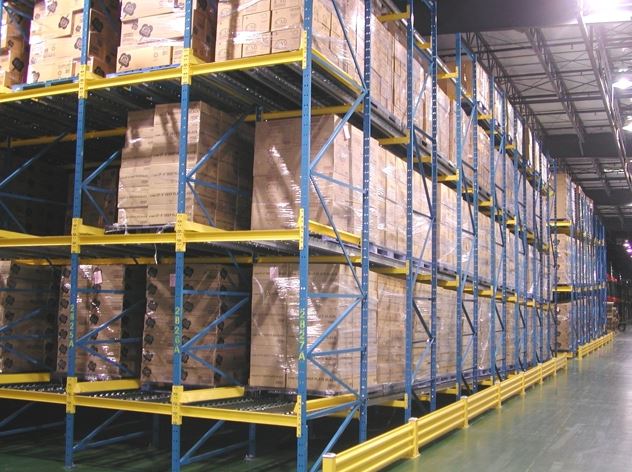High Density Pallet Storage: Comparing Pushback vs. Drive-In
The system you need depends on your load and your particular application

When comparing different methods of storing and accessing pallet loads on rack, the choices can be complex.
Do I go with Push-Back Rack using gravity feed to deliver loads to the front edge? What about the loss of vertical space? What if something gets hung up? How about Drive-In Rack? Do I trust my forklift drivers to maneuver carefully enough? What would a rack collapse cost me?
Which rack style to choose?
In the table below, you’ll find listed major factors and features that best serve moving pallets in and out of storage. It should help make your choice easier when you must decide on a rack style for your facility.
| Factors | Drive-In | Score | Push-Back | Score | ||||
| Picking / replenish speed | Slow | 1 | Fast | 3 | ||||
| Automatic replenishment in front | No | 1 | Yes | 3 | ||||
| Deep Lane Storage Capability | 10+ | 3 | 6 | 2 | ||||
| Optimizes vertical storage space | Good | 3 | Average | 2 | ||||
| Restricted by pallet length | None | 3 | Medium | 2 | ||||
| Restricted by pallet width | Medium | 2 | Yes | 1 | ||||
| Restricted by length + width combined | Yes | 1 | Yes | 1 | ||||
| Restricted by pallet weight | Medium | 2 | Medium | 2 | ||||
| Product damage potential | Medium | 2 | Medium | 2 | ||||
| Horizontal storage of pallets | Yes | 3 | No | 1 | ||||
| Pallet jams within the system | Low | 3 | Medium | 2 | ||||
| System derails | Low | 3 | Medium | 2 | ||||
| Run-away pallets fears | None | 3 | Medium | 2 | ||||
| Food-grade standard components | Optional | 2 | Optional | 2 | ||||
| Rust-proof | Optional | 2 | Optional | 2 | ||||
| Cooler / freezer compatibility | Optional | 2 | Optional | 2 | ||||
| Used rack compatibility | Low | 2 | Low | 1 | ||||
| Damaged rack part replacement | Easy | 3 | Hard | 1 | ||||
| Relocation of storage levels | Medium | 2 | Hard | 1 | ||||
| Forklift circulates inside rack structure | Yes | 1 | No | 3 | ||||
| Forklift rack abuse potential | High | 1 | Low | 3 | ||||
| Reach truck compatibility | No | 1 | Yes | 3 | ||||
| Accident frequency | High | 1 | Medium | 2 | ||||
| Resale value $$ | Medium | 2 | Medium | 2 | ||||
| Scorecard | Drive-In | 50 | Push-Back | 48 |
The right choice means long term savings year-in and year-out
As you can see by the scores, each rack style has significantly different features and benefits. Keep those in mind as you consider new rack storage or re-doing existing storage areas. Giving it careful thought now will save money, time, and labor over the long term.
Tags: space savings, storage
Scott Stone is Cisco-Eagle's Vice President of Marketing with 35 years of experience in material handling, warehousing and industrial operations. His work is published in multiple industry journals an websites on a variety of warehousing topics. He writes about automation, warehousing, safety, manufacturing and other areas of concern for industrial operations and those who operate them.



